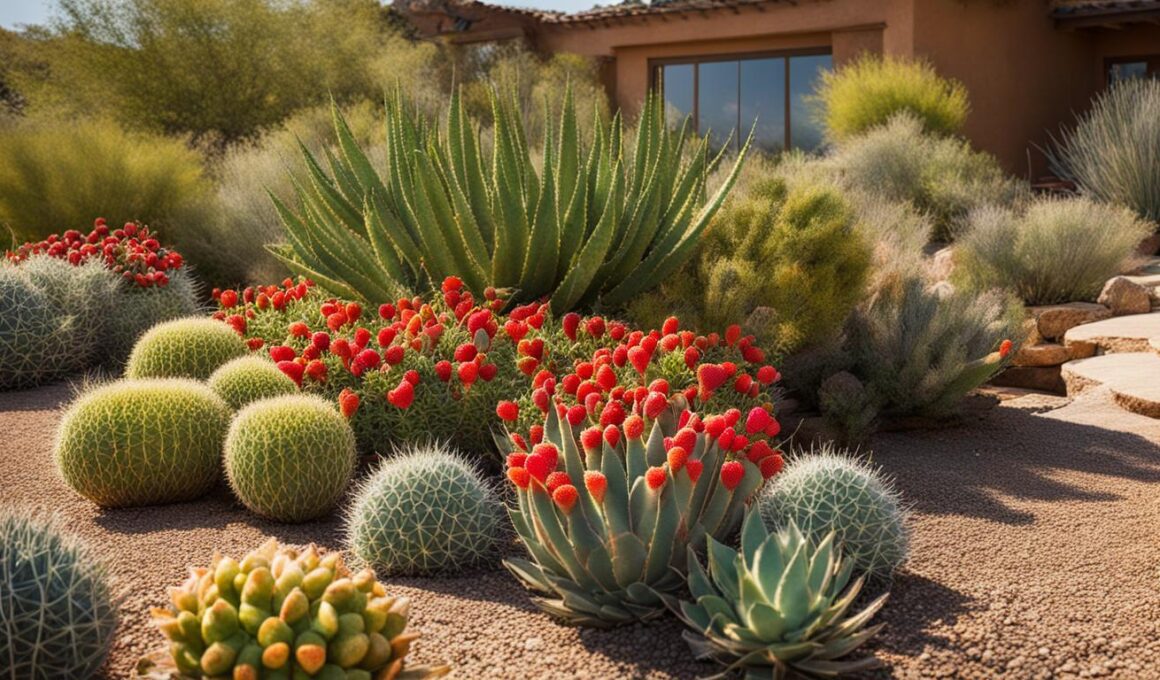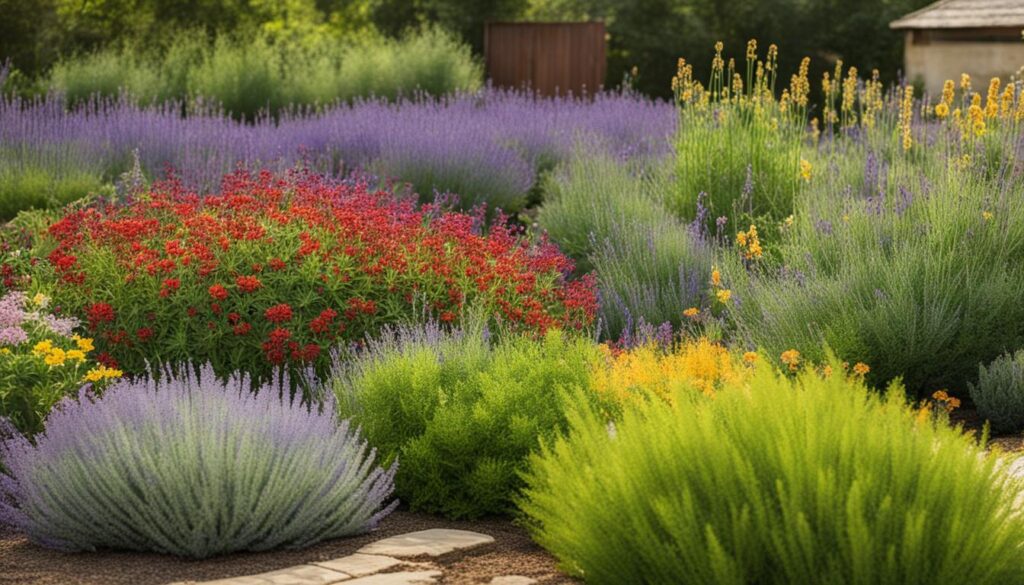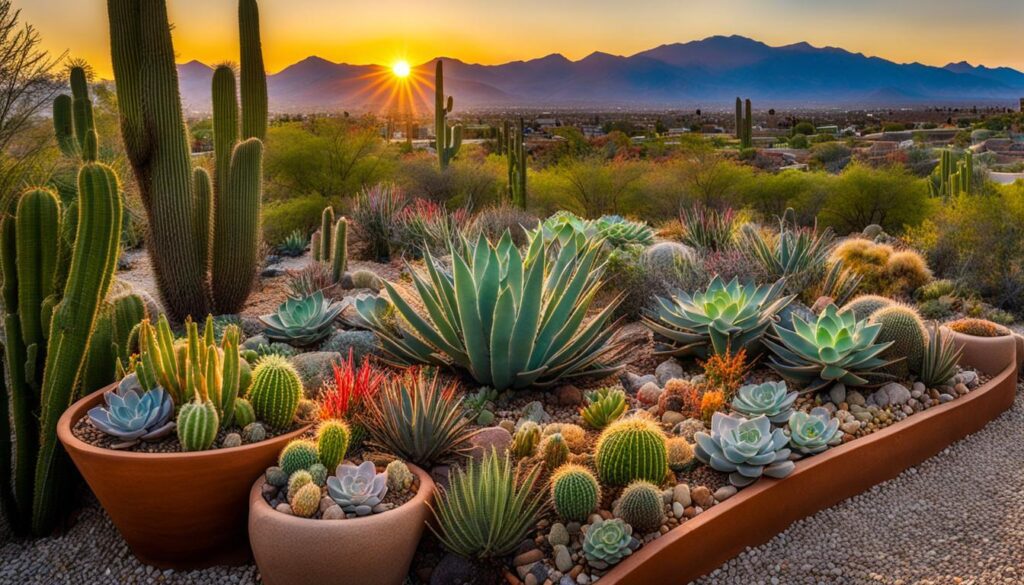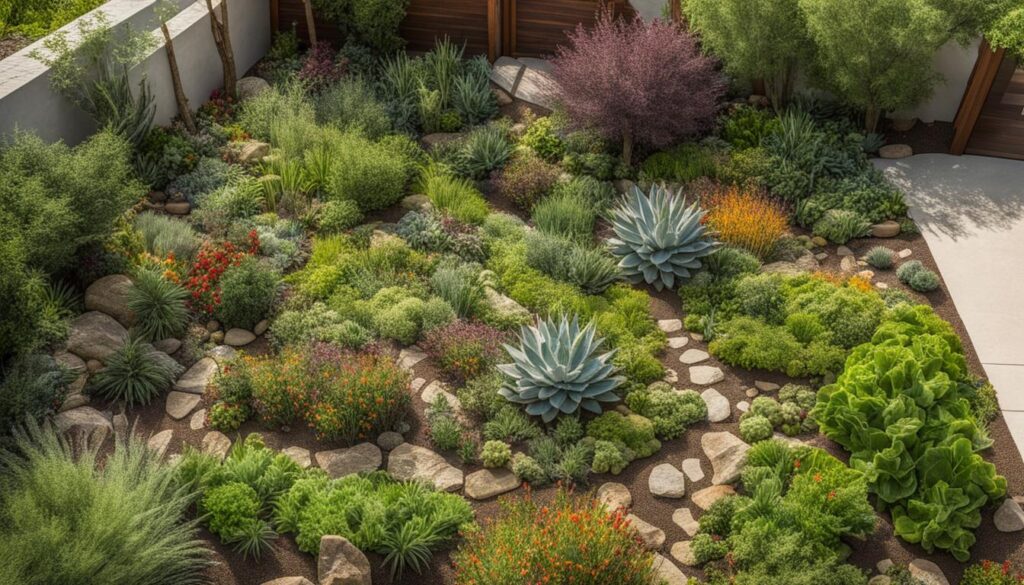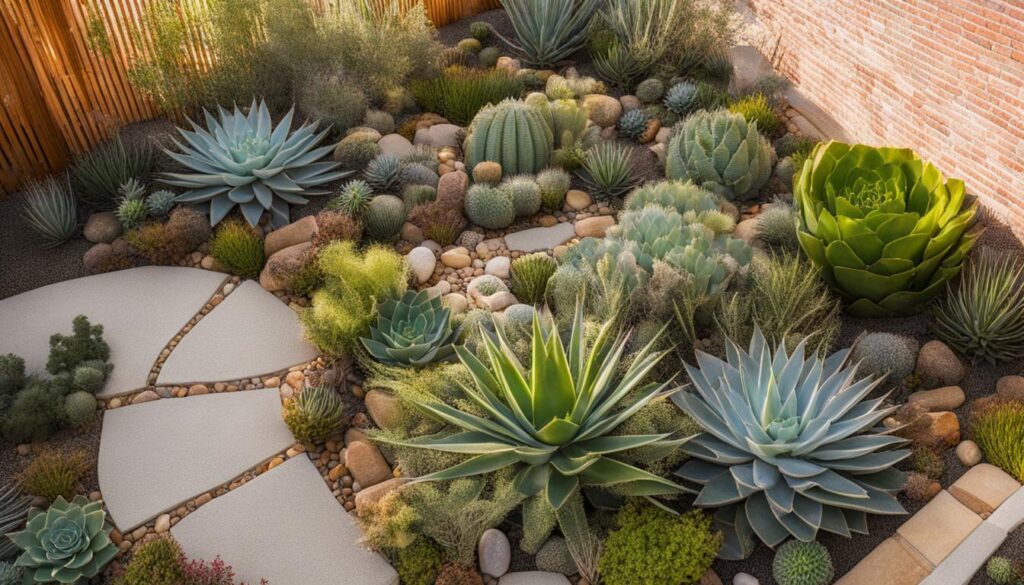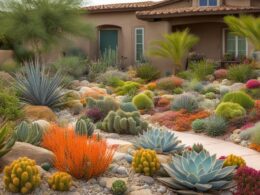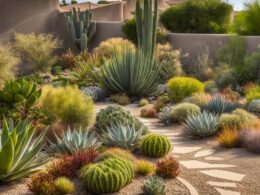When it comes to creating a beautiful garden that is both water-wise and productive, incorporating edible plants into your xeriscape design is a brilliant idea. Xeriscaping is a gardening technique that focuses on selecting plants that thrive in hot and arid conditions, making them suitable for water conservation efforts. By growing edible plants in your xeriscape garden, you not only enhance the aesthetics of your outdoor space but also enjoy the pleasure of harvesting your own homegrown treats.
Key Takeaways:
- Edible plants can be incorporated into xeriscape gardens for both aesthetic appeal and homegrown produce.
- Xeriscaping focuses on choosing plants that are compatible with hot, dry conditions, making them suitable for water conservation.
- Growing edible plants in your xeriscape garden allows you to enjoy the satisfaction of harvesting fresh, homegrown treats.
- Xeriscaping promotes water conservation efforts and sustainable gardening practices.
- By incorporating edible plants, you can create a visually stunning and deliciously abundant oasis in your outdoor space.
Herbs for Xeriscaping
When it comes to xeriscaping, incorporating herbs into your water-thrifty landscape is a fantastic choice. Not only are herbs drought-hardy and well-suited for low-water conditions, but they also offer a range of culinary and sensory benefits. Herbs like rosemary, lavender, thyme, sage, and oregano are excellent options for xeriscaping gardens.
These herbs not only add beauty and fragrance to your outdoor space but also provide you with fresh ingredients for your cooking endeavors. Furthermore, intermingling herbs with native wildflowers can create a visually appealing and diverse landscape design. The combination of herbs and native wildflowers can enhance the overall aesthetics of your xeriscape garden while promoting water efficiency.
Benefits of Herbs in Xeriscaping
- Culinary Value: Freshly harvested herbs from your xeriscape garden can elevate the flavor of your dishes, adding a touch of freshness and aroma to your meals.
- Water Conservation: Herbs are naturally drought-hardy and require minimal watering, making them ideal for xeriscaping. By incorporating herbs into your landscape, you can reduce water usage while still enjoying a beautiful garden.
- Pollinator Support: Herbs, especially those with flowers, attract beneficial insects like bees and butterflies, promoting pollination and overall ecosystem health in your garden.
- Aesthetics: The lush greenery and aromatic scents of herbs can transform your xeriscape garden into a visually stunning and inviting space.
Integrating herbs into your xeriscape garden not only adds practical benefits but also elevates the overall experience of your outdoor space. Whether you’re a culinary enthusiast or simply want to enjoy the beauty and fragrance that herbs bring, incorporating them into your water-thrifty landscape is a wonderful choice.
With their adaptability to dry conditions and their diverse range of uses, herbs are a valuable addition to any xeriscape garden. So go ahead, plant some rosemary, lavender, or thyme, and reap the rewards of their beauty, fragrance, and culinary delights.
Vegetable Plants for Xeriscaping
When it comes to xeriscaping, you might think that growing vegetables would be a challenge due to their water requirements. However, there are several vegetable plants that are well-suited for xeriscaping and can thrive in drier conditions. These drought-tolerant vegetables can be a great addition to your water-wise garden, providing you with fresh produce while conserving water.
Some examples of vegetable plants that are suitable for xeriscaping include tomatoes, peppers, zucchini, cucumber, and kale. These varieties have been bred to be more resilient to drought and can withstand longer periods without regular watering. Additionally, their deep root systems enable them to access water stored deeper in the soil, making them more adaptable to xeriscape environments.
One effective way to maximize water efficiency for vegetable plants in a xeriscape garden is by using raised beds. Raised beds provide better drainage and prevent water runoff, allowing you to water your plants more effectively. The elevated soil level also helps to retain moisture, reducing the need for frequent watering. Additionally, consider fall planting for your vegetable crops. By planting in the fall, vegetables can establish strong root systems before the heat of summer arrives, helping them better withstand drier conditions.
Benefits of Drought-Tolerant Vegetables in Xeriscaping:
- Conserves water: Drought-tolerant vegetables require less water, reducing your overall water consumption in the garden.
- Thrives in low-water conditions: These vegetables have adapted to drier climates and can still produce a bountiful harvest with minimal watering.
- Enhances sustainability: Growing your own vegetables in a xeriscape garden promotes self-sufficiency and reduces the reliance on store-bought produce.
- Fosters creativity in gardening: Incorporating drought-tolerant vegetables into your xeriscape garden allows you to experiment with unique and diverse plant varieties.
By choosing the right vegetable plants, utilizing raised beds, and implementing water-wise practices, you can successfully grow a productive and beautiful xeriscape garden filled with delicious homegrown vegetables.
Combining Herbs and Vegetables
In a xeriscape garden, you have the opportunity to combine the beauty and functionality of herbs and vegetables. Companion planting, the practice of growing certain plants together for mutual benefit, can be applied to herbs and vegetables as well. By intermingling herbs and vegetables, you can maximize space utilization while promoting a visually appealing and water-efficient garden.
One popular example of companion planting is the “Three Sisters” trio, which involves planting beans alongside corn and squash. This combination provides multiple benefits – the beans supply nitrogen to the soil, the corn provides structure for the beans to climb, and the squash shades the soil, reducing evaporation. This symbiotic relationship among the three plants not only enhances aesthetics but also improves the drought tolerance of the xeriscape garden.
When combining herbs and vegetables in a xeriscape garden, consider the specific needs and characteristics of each plant. Some herbs, such as rosemary and lavender, prefer dry conditions and can thrive alongside drought-tolerant vegetables like tomatoes, peppers, and cucumber. By strategically planning and pairing compatible plants, you can create a diverse and productive outdoor space that is both visually appealing and resilient to water scarcity.
Companion Planting Tips:
- Plant herbs that repel pests, like basil, near vegetable plants susceptible to insect damage.
- Consider the height and growth habit of different plants to ensure they don’t overshadow or compete for resources.
- Use aromatic herbs to attract beneficial insects that can help control pests in the garden.
- Rotate crops each season to prevent the buildup of soil-borne diseases and maintain the overall health of the garden.
Tips for Creating a Xeriscape Garden
To create an impressive and sustainable xeriscape garden, there are several tips and techniques you can implement. These strategies will help you conserve water, reduce maintenance, and create a thriving outdoor space. Here are some key considerations for successfully creating a xeriscape garden:
1. Utilize Raised Beds
Using raised beds is a smart choice for a xeriscape garden. Raised beds offer improved water retention and drainage, reducing the risk of water wastage and soil erosion. Additionally, they create a defined growing area for your plants, making it easier to manage and maintain your garden.
2. Apply Mulch
Mulching is an essential practice for xeriscaping. By applying a thick layer of mulch (around 3-4 inches) over the soil, you can significantly reduce water evaporation, regulate soil temperature, and suppress weed growth. Organic mulches, such as wood chips or straw, also enrich the soil as they decompose, enhancing the overall health of your plants.
3. Optimize Watering Techniques
Watering your xeriscape garden correctly is crucial for its success. Rather than frequent, shallow watering, which encourages shallow root growth and evaporation, water your plants deeply and infrequently. This allows the roots to reach deeper into the soil, promoting drought tolerance. Watering in the pre-dawn hours or evening minimizes water loss due to evaporation. Consider using drip irrigation or soaker hoses, which deliver water directly to the roots and minimize waste.
4. Implement Rainwater Harvesting
Rainwater harvesting is an eco-friendly way to supplement your watering needs and reduce reliance on municipal water sources. Install a rain barrel or a rainwater harvesting system to collect rainwater from your roof. This stored water can be used during dry spells, reducing the need for additional irrigation. Rainwater is also free from chemicals, making it a healthier choice for your plants.
By following these practical tips, you can create a beautiful, water-efficient xeriscape garden. Remember to choose plants suitable for your climate, incorporate native species, and consider the needs of your specific garden. With careful planning and maintenance, your xeriscape garden will flourish while minimizing water usage and promoting sustainability.
Benefits of Edible Xeriscapes
Creating an edible xeriscape garden offers several benefits. By growing your own food in a water-efficient and sustainable manner, you can contribute to water conservation efforts. In a world grappling with climate change and water scarcity, choosing edible plants for your xeriscape garden not only conserves water but also promotes self-sufficiency.
An edible xeriscape garden provides a source of fresh and nutritious homegrown produce. This not only reduces your reliance on store-bought vegetables but also allows you to enjoy the satisfaction of picking your own food straight from the garden. From vibrant herbs to flavorful vegetables, you can create a diverse and delicious garden that caters to your taste preferences.
“Growing your own food is not only rewarding but also promotes sustainability and environmental stewardship. By cultivating an edible xeriscape garden, you take control of your food production and reduce the carbon footprint associated with transportation and packaging.”
Maintaining an edible xeriscape garden also connects you to the natural world. It encourages you to observe the cycles of growth, appreciate the beauty of plants, and develop a deeper understanding of the ecosystem. The process of nurturing your garden fosters a sense of mindfulness and tranquility, providing a peaceful sanctuary within your own backyard.
Benefits of Edible Xeriscapes:
- Contributes to water conservation efforts
- Promotes self-sufficiency
- Provides fresh and nutritious homegrown produce
- Reduces reliance on store-bought vegetables
- Promotes sustainability and environmental stewardship
- Connects you to the natural world
With proper planning and care, you can experience the rewards of an abundant and beautiful garden while minimizing water usage. Embrace the benefits of edible xeriscapes and transform your outdoor space into a thriving oasis of conservation, sustainability, and self-sufficiency.
What Edible Plants Can I Use for Xeriscaping and Low Maintenance?
When it comes to xeriscaping and low maintenance gardening, choosing the best xeriscape maintenance plants is crucial. Consider using edible plants like lavender, rosemary, and thyme, which are not only drought-tolerant but also add flavor to your cooking. These plants require minimal water and care, making them ideal for xeriscaping.
Considerations for Successful Xeriscaping
When embarking on a xeriscaping project, there are several key considerations that can help ensure its success. These considerations include plant selection, soil testing, and weed control. By paying attention to these factors, you can create a thriving and water-efficient xeriscape garden that not only conserves water but also enhances the overall beauty of your outdoor space.
Plant Selection
Choosing the right plants is essential for a successful xeriscape garden. Consider selecting native or drought-tolerant plants that are well-adapted to your local climate and water conditions. These plants have evolved to thrive in hot, arid environments, requiring minimal watering once established. Research and consult with local gardening experts or agricultural extension agencies to identify suitable plant species for your xeriscape garden.
Soil Testing
Conducting a soil test is a vital step in creating a healthy xeriscape garden. Soil testing can provide valuable insights into the nutrient composition and pH level of your soil. This information helps you determine whether any amendments, such as organic matter or fertilizer, are needed to optimize plant growth. By addressing any nutrient deficiencies or excesses, you can create an ideal soil environment for your xeriscape plants to thrive.
Weed Control
Effective weed control is crucial in a xeriscape garden to prevent unwanted plants from competing for water and nutrients. Mulching is a recommended practice to suppress weed growth and conserve soil moisture. Apply a thick layer of organic mulch, such as wood chips or straw, around your xeriscape plants to inhibit weed germination and growth. Regularly inspect your garden and manually remove any emerging weeds to maintain a clean and weed-free environment.
By considering these factors – plant selection, soil testing, and weed control – you can set the foundation for a successful and water-efficient xeriscape garden. With careful planning and proper maintenance, your xeriscape garden will flourish, providing beauty, sustainability, and a bountiful harvest of homegrown delights.
Conclusion
Xeriscaping offers a practical and sustainable approach to gardening, allowing you to conserve water while enjoying the beauty and productivity of your outdoor space. By integrating edible plants into your xeriscape garden, you can further enhance its appeal and experience the satisfaction of growing your own food.
With the right selection of drought-tolerant herbs and vegetables suitable for a water-wise landscape, you can create an oasis that is both visually stunning and deliciously abundant. Consider companion planting to maximize space and promote drought tolerance among your plants.
Remember to implement proper watering techniques, such as deep and infrequent watering, and use mulch to reduce water evaporation. Additionally, consider installing a rain barrel or rainwater harvesting system to minimize the need for additional irrigation.
By following these guidelines and taking into account key factors like plant selection and weed control, you can create a thriving and water-efficient xeriscape garden that not only benefits the environment but also provides you with homegrown treats for your table.





